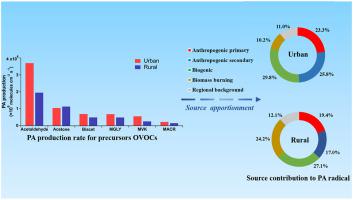Atmospheric Environment ( IF 5 ) Pub Date : 2021-06-14 , DOI: 10.1016/j.atmosenv.2021.118553 Shi-Yong Xia , Bo Zhu , Shao-Xia Wang , Xiao-Feng Huang , Ling-Yan He

|
Peroxyacetyl nitrate (PAN) is a typical secondary product of photochemical pollution and has attracted considerable attention because of its important role in atmospheric photochemical reactions and biotoxicity. Although existing studies have determined the dominant species of volatile organic compounds (VOCs) that can generate PAN, there are few studies including quantitative source analysis of PAN and precursor VOCs. In this study, PAN and precursor VOCs were measured at three sites in Shenzhen, a megacity on the southeast coast of China. The mean daytime (8:00–18:00) concentrations of PAN at the three sites during the sampling period were 0.70 ppbv (YMK, rural), 1.31 ppbv (DXC, residential) and 1.52 ppbv (FC, industrial), which had a different spatial distribution pattern compared to those of O3 and better reflect the degree of local anthropogenic emissions. Based on the steady-state model, the calculated PA radical formation rates cumulative contribution by six major carbonyl compounds at YMK and DXC were 4.4 × 106 molecules*cm−3*s−1 and 6.8 × 106 molecules*cm−3*s−1, respectively, and acetaldehyde contributed the highest percentage (44.4–54.3%) followed by acetone (15.1–25.6%), diacetyl (10.0–10.9%) and methylglyoxal (12.2–13.4%). Using an improved photochemical age-based parameterization method to analyze the daytime sources of PA radicals, the results show that biogenic sources were the most important source of PA radicals, accounting for 27.1% and 29.8% at YMK and DXC, respectively, and the contribution of anthropogenic secondary sources at DXC (25.8%) was significantly higher than at YMK (17.0%). The contribution of biomass burning at YMK reached 24.2%, emphasizing a critical role of biomass burning in atmospheric photochemical pollution in rural areas.


























 京公网安备 11010802027423号
京公网安备 11010802027423号